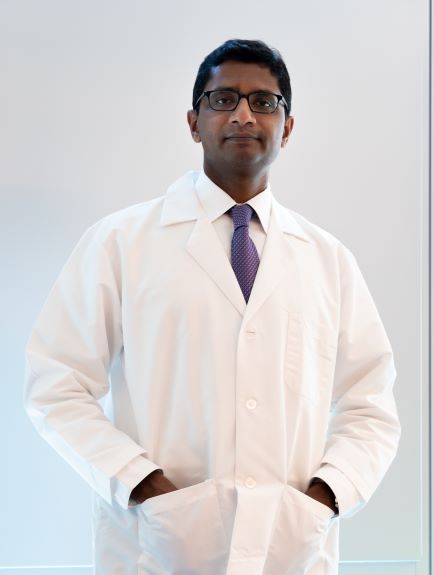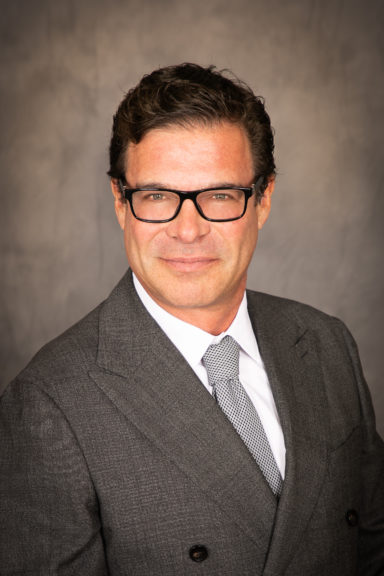Two of CHOC’s leading pediatric neurosurgeons recently shared their insights on how innovation is helping to close the gap between clinical needs and the availability of pediatric devices, but how there is much more work to be done to get critically ill kids the treatments they need.
The webinar, “From Clinical Insight to Commercialization: Innovations That Can Transform Pediatric Healthcare,” featured Dr. Suresh N. Magge, CHOC CS Neurosurgery Division Chief, and co-director of CHOC’s Neuroscience Institute, and Dr. Michael G. Muhonen, the institute’s previous co-director.
Hosting the “OC LIFe (Lifesciences Innovators Forum)” on April 28, 2021 was Dr. Terence Sanger, a physician, engineer, and computational neuroscientist and vice president, chief scientific officer at CHOC, and vice chair of research for pediatrics at the UCI School of Medicine.



“As innovators, we should never be satisfied,” said Dr. Sanger, who specializes in movement disorders and who helped pioneer deep brain stimulation, which has yielded positive outcomes. “An innovative and collaborative approach is required so that pediatric patients can have access to the fit-for-purpose devices they need.”
Brain tumor treatments
Drs. Magge and Muhonen took turns discussing new neurosurgical technologies and opportunities for interventions.
Dr. Magge focused on new technology that has been used to treat brain tumors, which are a different breed compared to adult brain tumors. More often, Dr. Magge said, pediatric brain tumors are of a lower grade and can be treated.
“Many kids have gone on to live good lives thanks to innovation, research, and applying the technologies we have,” Dr. Magge said.
In one example, he detailed how microsurgical techniques have greatly aided in the removal of a craniopharyngioma, a benign tumor that usually arises in the base of the brain near the pituitary gland that can be dangerous or life threatening if not treated.
“If you can get the tumor out,” Dr. Magge said, “you can cure the patient. But it’s challenging because it’s in a deep part of the brain.”
During the procedure, the neurosurgeon must locate some of the natural divides of the brain and separate them out to get to the tumor. Microsurgery allows the neurosurgeon to work between very narrow areas.
With a technology known as surgical navigation, neurosurgeons can pinpoint exactly where they are in the brain and get to very specific areas. Another technology is a powerful microscope that magnifies small areas of the brain. In addition, ultrasound and MRI within the operating room can tell you in surgery if there is any tumor left.
“This is all thanks to innovation and technology that we are incorporating in surgery,” Dr. Magge said.
Dr. Magge then discussed medulloblastomas, one of the most common types of tumors neurosurgeons see in kids. Such large tumors grow in the lower back part of the brain — the cerebellum, which is involved in muscle coordination, balance, and movement.
Thirty years ago, Dr. Magge said, kids with medulloblastomas received high doses of radiation that left a lot of them with severe cognitive and hormonal deficits.
The treatment for medulloblastomas had evolved so that less radiation is used in the treatment. In addition, in the last decade, researchers have discovered that these tumors differ significantly based on their genetic makeup.
“These tumors have multiple genetic subtypes, and we can target them genetically with different types of treatments,” Dr. Magge explained.
He said innovation also has led to advances in the treatment of diffuse intrinsic pontine gliomas (DIPG), highly aggressive and difficult-to-treat brain tumors that grow in an area of the brainstem that controls many of the body’s most vital functions such as breathing, blood pressure, and heart rate.
The prognosis for DIPGs remains very poor because they are considered non-resectable tumors – ones that cannot be removed with surgery. Life expectancy is eight to 12 months after diagnosis.
“This is one of the toughest diagnoses we have to give to families because of the lack of good treatment options,” Dr. Magge said.
For years, biopsies were ruled out because they could cause significant side effects, and neurosurgeons saw no point in performing them since there were no treatments. Without biopsies, the tumor tissue could not be studied in a lab for potentially effective treatments.
Technology has changed this is the last 10 years, Dr. Magge said, thanks to stereotactically guided needles that allow neurosurgeons to perform DIPG biopsies safely.
“We at CHOC and other pediatric hospitals have shown we can do this safely with minimum morbidity,” said Dr. Magge, who has participated in a large clinical trial regarding DIPG biopsies.
“With this technology, we can get tissue and genetically sequence these tumors and find out if there are certain mutations that are particularly amenable to certain treatments,” Dr. Magge said of this precision-medicine approach.
“These are small steps along the path,” he added. “We have by no means found all the answers. We have so much farther to go, but I think we’re on the right track.”
Closing the gap
Dr. Muhonen recalled one of the first patients he saw when he came to Orange County in 1995: a young girl with severe spasms in her legs. She couldn’t walk without assistance.
“We had to do something innovative,” Dr. Muhonen said.
He had injected baclofen, a muscle relaxer and antispasmodic agent, into the spinal column of an adult the year before, but never in a child. After receiving approval to do so, he implanted a device that allowed long-term injection of baclofen in the girl’s spinal cord. Six months later, she was able to walk and even run on her own.
In another example of innovation, Dr. Muhonen worked for five years on helping to develop a wireless sensor to measure pressure in the brain. The FDA approved the device for adults, but has yet to for children.
Most companies get medical devices approved for adults because it’s easier, because there’s a larger patient population, and there’s more money to be made.
“The bulk of challenges associated with developing and accelerating pediatric medical devices is market-driven,” Dr. Muhonen said. “We want children to get the best possible care available, but the relative market size is small compared to adults, which is one reason some device makers avoid it.”
One of Dr. Muhonen’s chief interests is treating hydrocephalus, the buildup of fluid in the ventricles deep within the brain.
Innovation in this area has been a long time coming, he said, since the invention in the early 1950s of a shunt that drained fluid from the brain into the abdominal cavity. Many problems can occur with the shunt, such as spontaneously twisting up into a knot due to a child’s movement or calcifying and breaking apart after being in the body for a long time. Kids who received a shunt typically face more than 10 surgeries, Dr. Muhonen said.
“The holy grail for pediatric neurosurgeons is, can we create a ‘smart shunt?’” Dr. Muhonen said.
An ideal shunt, he said, could be programmed to drain a specific amount of water and measure pressure.
Dr. Muhonen said a derivative from cone snails is inspiring research into a new generation of painkillers for adults, but has yet to be approved for testing on kids.
Impediments to innovation
Dr. Sanger asked Drs. Magge and Muhonen about impediments to pediatric innovation. Ethically, he posited, shouldn’t new devices and other innovations be tested in adults first?
“I don’t think there are any easy answers to this,” Dr. Magge said. “It’s difficult. You don’t just do a biopsy on a tumor that might help kids in the future. If you perform surgery on a child, there has to be some potential benefit to that child.”
Dr. Muhonen said children are the most vulnerable of society and thus are the worthiest of innovations in healthcare.
Dr. Magge said he and others at CHOC have been looking at ways to inject dyes to paint brain tumors to more easily distinguish them from healthy brain tissue.
“Sometimes the tumor is obvious, sometimes it’s more challenging,” he said. While dye injections have been used in adults, it is less commonly used in children.
Dr. Sanger mentioned “big effect sizes” resulting from innovation in pediatric medicine.
“We’re used to the idea of statistical research involving a lot of patients,” he said. “But this is a different type of research. You take someone who has never walked before and now they’re running. You take someone who is going to die of a brain tumor and now they’re not. These are very big effect sizes.”
“There are good reasons for the regulations we have,” Dr. Magge said. “That being said, that doesn’t mean we can’t innovate. And there are mechanisms for us to do that, and to do it safely.
“Our first motto is, ‘Do no harm,’” Dr. Magge continued. “I always tell residents to do the right thing and treat each patient as if they were your own child. Doing the right thing means asking the right questions. ‘How can we do this better?’ You can always learn from everything you do. At the end of every procedure, you critique it. You’re constantly learning. That’s what I always encourage.”
Dr. Sanger closed the session by noting that clinical evidence should ideally be reflective of the spectrum of pediatric patients and the developmental differences that can impact the use and effectiveness of medical devices.
“This is a collaborative effort,” he added. “CHOC is working closely with the FDA’s new System of Hospitals for Innovation in Pediatrics – Medical Devices (SHIP-MD) Program, our academic partners, industry, entrepreneurs and the investor community to close the gaps. Also, we are now practicing medicine in a world immersed with data. Advances in computing and health information technology have given rise to new sources and types of biomedical data. Clinicians know real-world data will continue to emerge as a source of clinical evidence.”
The Presenting Sponsor of the webinar, “From Clinical Insight to Commercialization: Innovations That Can Transform Pediatric Healthcare,” was Biocom California, which connects life science organizations to each other so they can collaborate and work smarter together. The CHOC Research Institute co-sponsored the hour-plus session.
The webinar was presented in partnership with SBDC @ UCI Beall Applied Innovation, a resource for any high-technology, high-growth, scalable venture from the community or the UCI ecosystem that needs help with business planning, business development and funding-readiness.




